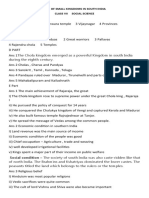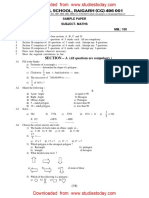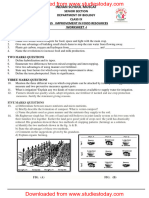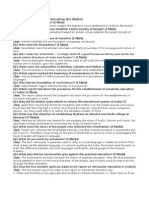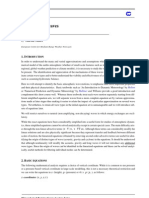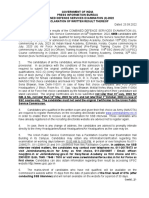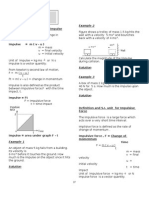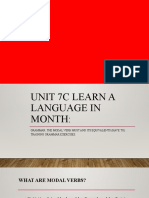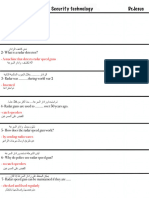Devotional Paths
Devotional Paths
Uploaded by
Anmol VIshwakarmaCopyright:
Available Formats
Devotional Paths
Devotional Paths
Uploaded by
Anmol VIshwakarmaCopyright
Available Formats
Share this document
Did you find this document useful?
Is this content inappropriate?
Copyright:
Available Formats
Devotional Paths
Devotional Paths
Uploaded by
Anmol VIshwakarmaCopyright:
Available Formats
DEVOTIONAL PATHS TO THE DIVINE
Q/A
Q1. Who were Nayanars and Alvars? How did they spread their ideas?
Ans. Nayanars and Alvars were were bhakti saints devoted to lord Shiva and Vishnu
respectively. They went from place to place, composing exquisite poems in praise of their
deities.
Q2. Define the term Hagiography.
Ans. The word Hagios means holy/saint and Graphia means writing. Hagiography is
therefore, the writings of the lives of saints.
Q3. What were the beliefs of the Virashaivas?
Ans. (i) The Virashaiva movement was started by Basavanna and his companions Allama
Prabhu and Akkamahadevi.
(ii) The Virashaivas argued against ideas about caste and treatment of women.
(iii) They were also against all forms of ritual and idol worship.
Q4. Write a note on the Bhakti saints of Maharashtra.
Ans. (i) A great number of saint poets like – Janeshwar, Namdev, Eknath and Tukaram arose
in Maharashtra.
(ii) They rejected all forms of ritualism and social differences based on birth.
(iii) They rejected the ideas of renunciation and preferred to live with their families.
(iv) They insisted that Bhakti lay in sharing the pain of others.
Q5. How did the Nathpanthis, Siddhas and Yogis aim to achieve salvation?
Ans. (i) They advocated renunciation of the world.
(ii) To them the path to salvation lay in meditation on the formless Ultimate Reality.
(iii) To achieve the unity with Ultimate Reality they advocated training of the mind and
body through yogasanas, breathing exercises and meditation.
Q6. Who were Sufis and what their beliefs?
Ans. (i) Sufis were Muslim mystics who rejected outward religiosity.
(ii) They emphasized love and devotion to God and compassion towards all fellow
human beings.
(iii) Sufis composed poems expression their feelings for their God.
(iv) They developed elaborate methods of training using zikr (chanting of name), sama
(singing), raqs (dancing) etc.
Q7. What were hospices? Elaborate on their importance.
Ans. Rest houses for travellers, maintained by Sufi saints are called Hospices or Khanqah.
Their importance was –
(i) Devotees of all descriptions including royalty, flocked to these Khanqahs.
(ii) People discussed spiritual matters with the saint and sought his help in solving
their worldly problems.
Q8. Write short notes on Tulsidas, Surdas, Chaitanyadeva and Shankaradeva.
Ans. (i) Goswami Tulsidas – He imagined God in the form of Lord Rama. He composed the
famous poem Ramcharitmanas in Awadhi language.
(ii) Surdas – Was an ardent devotee of Lord Krishna. He composed many poems such
as; Sursagara, Surasaravalli and Sahitya Lahari.
(iii) Chaitanyadeva – Was a bhakti saint from Bengal. He preached selfless devotion to
Radha-Krishna.
(iv) Shankaradeva – Was a bhakti saint of Assam who emphasized devotion to Lord
Vishnu. He began the practice of setting up namghar or house of recitation and
prayer.
Q9. State the relevance of Mirabai.
Ans. (i) Mirabai was a Rajput princess who became a disciple of saint Ravidas.
(ii) She was devoted to Lord Krishna and composed numerous bhajans dedicated to
him.
(iii) Her songs challenged the norms of caste system and are still very popular.
Q10. What were the major ideas Kabir? How did he express them?
Ans. Kabir was a very influential saint of the 15th- 16th centuries. His ideas were –
(i) He rejected all major religious traditions and caste system.
(ii) He openly ridiculed all forms of external worship.
(iii) He believed in a formless Supreme God and preached that the only path to
salvation was through bhakti or devotion.
(iv) He used the language of the ordinary people and gained followers from both
Hinduism and Islam.
Q11. What were the major teachings of Baba Guru Nanak?
Ans. Baba Guru Nanak was the first Guru of the Sikhs. His teachings were –
(i) He emphasized the importance of one God.
(ii) He insisted that caste, creed or gender was irrelevant for attaining liberation.
(iii) His idea of liberation was not a state of inert bliss but rather the pursuit of active
life with a strong sense of social commitment.
(iv) He used the terms nam (right worship), dan (welfare of others) and isnan (purity
of conduct).
_________________________________________
You might also like
- NFC 33-020-2013Document20 pagesNFC 33-020-2013Jonutz100% (4)
- Kenneth E Hagin - Leaflet - The Holy Spirit, Questions & AnswersDocument4 pagesKenneth E Hagin - Leaflet - The Holy Spirit, Questions & AnswersAnselm MorkaNo ratings yet
- Laxmi Bai, The Queen of Jhansi: Lesson - 15Document7 pagesLaxmi Bai, The Queen of Jhansi: Lesson - 15ABDQNo ratings yet
- DiscipleCourse NotesDocument8 pagesDiscipleCourse NotesNashvinNo ratings yet
- Reading 3 - Test 1 With KeyDocument6 pagesReading 3 - Test 1 With KeyIsabel Black0% (1)
- Devotional Path To The DivineDocument7 pagesDevotional Path To The DivinesuvashreeNo ratings yet
- Grade-7 - Science - Chapter13 - Motion-and-Time Exam Important Questions by Byju'sDocument9 pagesGrade-7 - Science - Chapter13 - Motion-and-Time Exam Important Questions by Byju'syegiseb684No ratings yet
- Essay On Our National SymbolsDocument25 pagesEssay On Our National SymbolsAnjum Ansh KhanNo ratings yet
- Chapter Notes - Markets Around Us: Doon International School, BasirhatDocument8 pagesChapter Notes - Markets Around Us: Doon International School, Basirhatblah blahNo ratings yet
- CBSE Class 7 Social Science Our Past 2 Chapter 2 New Kings and Kingdoms Important Questions 2023-24Document8 pagesCBSE Class 7 Social Science Our Past 2 Chapter 2 New Kings and Kingdoms Important Questions 2023-24Gamers For Life . comNo ratings yet
- The Mauryan EmpireDocument3 pagesThe Mauryan EmpirePrashantt sNo ratings yet
- L-5 Early Vedic NotesDocument7 pagesL-5 Early Vedic NotesVivan Aboti WorkNo ratings yet
- Motion and TimeDocument13 pagesMotion and TimeRajeevSangam100% (1)
- Cbse Mathematics Question Bank Term Ii Class Vii RoseDocument17 pagesCbse Mathematics Question Bank Term Ii Class Vii RoseDeep ManeNo ratings yet
- CBSE Class 6 Kannada Question Paper SA2 2014Document4 pagesCBSE Class 6 Kannada Question Paper SA2 2014Venkanna Huggi H100% (1)
- 06 Social Science History Key Notes Ch06 Kingdoms Kings and and Early RepublicDocument2 pages06 Social Science History Key Notes Ch06 Kingdoms Kings and and Early RepublicAYUSH JOSHINo ratings yet
- From A Kingdom To An Empire Class 6 Worksheet History Chapter 7Document2 pagesFrom A Kingdom To An Empire Class 6 Worksheet History Chapter 7Kusuma Haranath100% (1)
- Human Environment Interactions (The Tropical and The Subtropical Region)Document5 pagesHuman Environment Interactions (The Tropical and The Subtropical Region)suvashreeNo ratings yet
- Rise of Small Kingdoms in South India Que AnsDocument4 pagesRise of Small Kingdoms in South India Que AnsMadhusmita SahooNo ratings yet
- St. Joseph's International School, HisarDocument2 pagesSt. Joseph's International School, HisarRekha KaushikNo ratings yet
- Class7 - Human Environment Interaction - Tropical and SubtropicalDocument3 pagesClass7 - Human Environment Interaction - Tropical and SubtropicalGaurav MalikNo ratings yet
- 7 Social Science Tribes Nomads and Settled CommunitiesDocument7 pages7 Social Science Tribes Nomads and Settled CommunitiesRajeevSangamNo ratings yet
- Transportation in Animals and Plants Worksheet 8Document2 pagesTransportation in Animals and Plants Worksheet 8Parul ShahNo ratings yet
- Workbook Exercise of Motion and TimeDocument7 pagesWorkbook Exercise of Motion and Timesmi_santhoshNo ratings yet
- 1731915719maths Class Vii Half Yearly Exam Sample Paper 01Document5 pages1731915719maths Class Vii Half Yearly Exam Sample Paper 01sonu kumarNo ratings yet
- Class 6th Social Science Geography Chapter 5 Major Domains of The EarthDocument7 pagesClass 6th Social Science Geography Chapter 5 Major Domains of The EarthVarun kumarNo ratings yet
- Class 5 Maths Sample Paper SA1 2015Document4 pagesClass 5 Maths Sample Paper SA1 2015ik62299No ratings yet
- Important Questions For CBSE Class 7 Science Chapter 5 - Acids, Bases and SaltsDocument5 pagesImportant Questions For CBSE Class 7 Science Chapter 5 - Acids, Bases and SaltsADARSH RAJ SINGHNo ratings yet
- Class 6 History Chapter 6 Kings Kingdoms Early Republics IDocument5 pagesClass 6 History Chapter 6 Kings Kingdoms Early Republics IThe Vfx CloudNo ratings yet
- CHAPTER-9, Respiration in Organisms.Document3 pagesCHAPTER-9, Respiration in Organisms.HarshitAhelani2379ScribdNo ratings yet
- Cls 8 Direct2Document4 pagesCls 8 Direct2Galistus GamingNo ratings yet
- Class 6 ICSE History & Civics Sample Paper Term 2 Model 1Document2 pagesClass 6 ICSE History & Civics Sample Paper Term 2 Model 1Sunaina Rawat100% (3)
- D.A.V Institutions, West Bengal Zone Annual ExaminationDocument3 pagesD.A.V Institutions, West Bengal Zone Annual ExaminationSagnik MondalNo ratings yet
- Class 7 Chapter 5 WaterDocument10 pagesClass 7 Chapter 5 WaterANIRBAN DAMNo ratings yet
- 6 SSCDocument2 pages6 SSCsamina shaikhNo ratings yet
- 7 History 1Document9 pages7 History 1Nikunj KoladiyaNo ratings yet
- CBSE Class 6 Data Handling WorksheetDocument2 pagesCBSE Class 6 Data Handling WorksheetAmrita SenNo ratings yet
- History CH 7 Tribes PDFDocument4 pagesHistory CH 7 Tribes PDFarasu_kavi20038833No ratings yet
- CBSE Class 9 Science Worksheet - Improvement in Food ResourcesDocument2 pagesCBSE Class 9 Science Worksheet - Improvement in Food ResourcesKULDEEP PALANo ratings yet
- Cbse 7 Visualising Solid ShapesDocument3 pagesCbse 7 Visualising Solid ShapesSagar NaikNo ratings yet
- Askiitians: Class: Vi Subject: Physics Topic: Motion and Measurement of Distance No. of Questions: 21Document4 pagesAskiitians: Class: Vi Subject: Physics Topic: Motion and Measurement of Distance No. of Questions: 21Amrita SenNo ratings yet
- Victor Public School SESSION (2022-23) Social Science (History) Class-Viii Chapter-1: How, When and Where Worksheet-A: Questions - AnswersDocument2 pagesVictor Public School SESSION (2022-23) Social Science (History) Class-Viii Chapter-1: How, When and Where Worksheet-A: Questions - AnswersNiyati RUSTAGINo ratings yet
- Algebra: Class VI. BPS Maths WorksheetDocument2 pagesAlgebra: Class VI. BPS Maths Worksheetfgh ijkNo ratings yet
- Ch-2 From Hunting Gathering To Growing FoodDocument6 pagesCh-2 From Hunting Gathering To Growing FoodPriya ChughNo ratings yet
- Don Bosco Splendid Home 1 Terminal Examination-2017 Class-VIII English - IiDocument3 pagesDon Bosco Splendid Home 1 Terminal Examination-2017 Class-VIII English - IiproodootNo ratings yet
- 8th CBSE From Trade To TerritoryDocument4 pages8th CBSE From Trade To TerritorymanojboaNo ratings yet
- Transportation in Plants and Animals Ncert and Extra QuestionsDocument6 pagesTransportation in Plants and Animals Ncert and Extra QuestionsNaitik MeenaNo ratings yet
- Transportation in Animals and Plants Worksheet 10 PDFDocument2 pagesTransportation in Animals and Plants Worksheet 10 PDFParul ShahNo ratings yet
- CBSE Sample Paper Class 7 Science Set 3Document5 pagesCBSE Sample Paper Class 7 Science Set 3Sumanta Pan100% (2)
- CBSE Class 8 Political Science (Civics) Chapter 8 Notes - Confronting MarginalisationDocument7 pagesCBSE Class 8 Political Science (Civics) Chapter 8 Notes - Confronting MarginalisationSainu RafeequeNo ratings yet
- Land, Soil, Water, Natural Vegetation and Wildlife Resources (Assignment - 2)Document4 pagesLand, Soil, Water, Natural Vegetation and Wildlife Resources (Assignment - 2)gobinda prasad barmanNo ratings yet
- Worksheet - Tribes, Nomads and Settled CommunitiesDocument3 pagesWorksheet - Tribes, Nomads and Settled Communitiesgamerboy1234567890000No ratings yet
- 22 Omission Practice Exercise PDFDocument1 page22 Omission Practice Exercise PDFKrithika SrinivasanNo ratings yet
- Delhi Public School Newtown: SESSION 2015-2016 Final ExaminationDocument8 pagesDelhi Public School Newtown: SESSION 2015-2016 Final ExaminationRaja KumarNo ratings yet
- Class 6th Social Science History Chapter 5 What Books and Burials Tell UsDocument7 pagesClass 6th Social Science History Chapter 5 What Books and Burials Tell UsDhahajeed Ibnu100% (1)
- Class 6 Fun With Magnets Exercise Question and Answer Plus Inner (Extra) Question and AnswerDocument8 pagesClass 6 Fun With Magnets Exercise Question and Answer Plus Inner (Extra) Question and Answerdebasishnath9593913213No ratings yet
- Major LandformDocument12 pagesMajor LandformMohd. JavedNo ratings yet
- Unitary Method Worksheet-2Document3 pagesUnitary Method Worksheet-2LokeshNo ratings yet
- SS Assignment Class 9 CBSEDocument4 pagesSS Assignment Class 9 CBSEgurdeepsarora8738No ratings yet
- Civilising The NativeDocument24 pagesCivilising The Nativeprakeerthbks100% (8)
- 6thL4 (H) ClassworkDocument3 pages6thL4 (H) Classworksumendra singh100% (1)
- Class V EVS NotesDocument9 pagesClass V EVS NotesVijay B Patil0% (1)
- History Chapter 7 Devotional Paths To The Divine: Ncert QuestionsDocument4 pagesHistory Chapter 7 Devotional Paths To The Divine: Ncert QuestionsKomal PanchalNo ratings yet
- A Study On Employee Retention in Rane Madras LTD, Chennai: Submitted byDocument76 pagesA Study On Employee Retention in Rane Madras LTD, Chennai: Submitted byJasmin RaichelNo ratings yet
- Digitally Programmable AmplifierDocument7 pagesDigitally Programmable AmplifierDRAGAN ANDRICNo ratings yet
- 2 Sa 970Document4 pages2 Sa 970AlexandreMdeSouzaNo ratings yet
- Atmospheric WavesDocument21 pagesAtmospheric WavesGeorge TsavdNo ratings yet
- G481 Module 2 Forces in Action QuestionsDocument13 pagesG481 Module 2 Forces in Action QuestionsAmberNo ratings yet
- WR Cdsii 2022 Eng 230922Document24 pagesWR Cdsii 2022 Eng 230922manjeet singh sajwanNo ratings yet
- LESSON 2.6. Impulse, Impulsive Force and SafetyDocument7 pagesLESSON 2.6. Impulse, Impulsive Force and Safetychekgu_2007No ratings yet
- Final Exam GradesDocument4 pagesFinal Exam GradesHANI SbinatiNo ratings yet
- Modal VerbsDocument16 pagesModal VerbsSoyun AnnayewNo ratings yet
- قطعة (Unit 2) الرادارDocument4 pagesقطعة (Unit 2) الرادارaaaeee1114890No ratings yet
- TLE 7-8 ICT - IllustrationDocument8 pagesTLE 7-8 ICT - IllustrationLady Antoniette M. BonggotNo ratings yet
- Dissertation Crossword Puzzle ClueDocument6 pagesDissertation Crossword Puzzle ClueBuyAPaperOnlineColumbia100% (1)
- Casing API ConnectionsDocument3 pagesCasing API ConnectionsBrahim Letaief100% (1)
- Topic 1 - Defining Leader & LeadershipDocument39 pagesTopic 1 - Defining Leader & LeadershipMuntasir AhmmedNo ratings yet
- Solving Problems (Lecture 23B)Document6 pagesSolving Problems (Lecture 23B)Suraj sssNo ratings yet
- Lean Manufacturing and Operational Efficiency of Nestle Nigeria Plc. Using Data Envelopment Analysis (DEA)Document29 pagesLean Manufacturing and Operational Efficiency of Nestle Nigeria Plc. Using Data Envelopment Analysis (DEA)k60.2111213014No ratings yet
- Spt-Portfolio-Template Plain PaduraDocument6 pagesSpt-Portfolio-Template Plain PaduraAlexis PaduraNo ratings yet
- Divisions of Art StudyDocument21 pagesDivisions of Art StudyJewel SkyNo ratings yet
- Catalogo ASCODocument4 pagesCatalogo ASCOIkaro MatosNo ratings yet
- Fire and Smoke Dampers BY: Ben TurnerDocument10 pagesFire and Smoke Dampers BY: Ben TurnerRolandNo ratings yet
- Statistic Form 4Document34 pagesStatistic Form 4Juan Chee WongNo ratings yet
- English Lesson Plan Year 1bestari - Friday: Day Date Class Time Topic ThemeDocument2 pagesEnglish Lesson Plan Year 1bestari - Friday: Day Date Class Time Topic ThemeWan MaisarahNo ratings yet
- FAQ For AMA AdmissionDocument4 pagesFAQ For AMA AdmissionasfafafcNo ratings yet
- IMADDocument2 pagesIMADImad Muhammed AliNo ratings yet
- Jabsco Flexible Impeller PumpsDocument46 pagesJabsco Flexible Impeller PumpsstratoschaNo ratings yet
- FN411Document22 pagesFN411Varintorn ErNo ratings yet


















